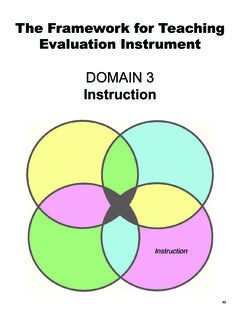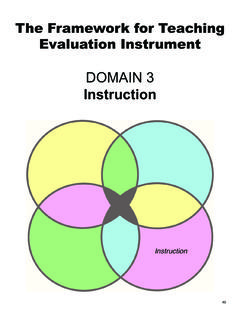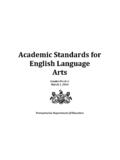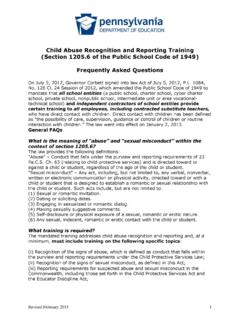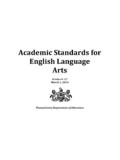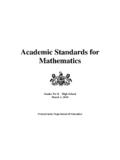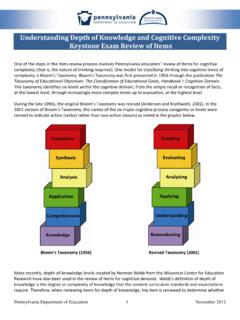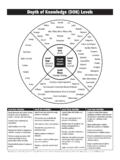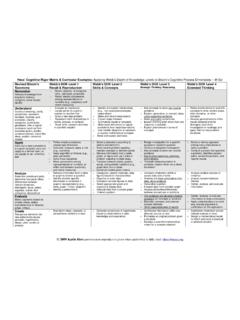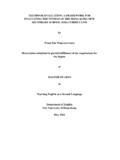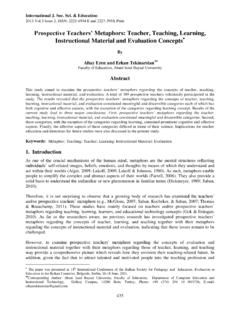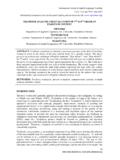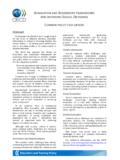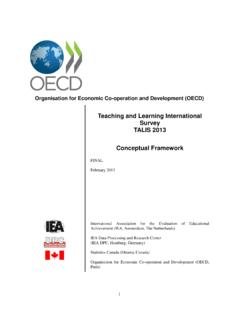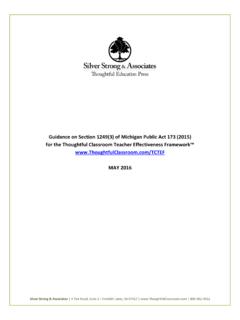Transcription of The Framework for Teaching Evaluation Instrument
1 The Framework for TeachingEvaluation Instrument2011 Editionby Charlotte DanielsoniThe Framework for TeachingEvaluation InstrumentCharlotte DanielsonThe Danielson Group12 Gordon Way Princeton, NJ 08540 Phone: (609) 848-8714 Fax (609) 482-4712 Web site: E-mail: 2011 The Danielson GroupAll rights reserved. First edition 2011. Cover art and design by Corinne Gordon : 978-0615597829 The Framework for Teaching Evaluation Instrument (2011) is available in a PDF format from theDanielson Group website. Any educator may download this file and use the print version in his orher own setting. However, The Framework for Teaching Evaluation Instrument (2011) is made available for use byeducators in print format only.
2 The Framework for Teaching Evaluation Instrument (2011) may notbe incorporated into any third party software system. The Danielson Group has entered into anexclusive agreement with Teachscape for the digital rights to publish and distribute software prod-ucts based upon The Framework for Teaching Evaluation Instrument (2011). Acceptance of thisdocument constitutes agreement not to: (i) copy, modify, translate, or create derivative works fromthe Instrument ; (ii) load, integrate or incorporate any portions of the Instrument with any other pub-lication, software, database or other content or work; (iii) transfer the Instrument to any third partyfor commercial use; or (iv) remove or alter any notices in the Instrument .
3 The Framework forTeaching Evaluation Instrument (2011) is provided on an as-is basis and no warranties areexpressed or Framework for TeachingEvaluation InstrumentContents:Introduction .. ivDomain 1 .. 1 Domain 2 .. 27 Domain 3 .. 49 Domain 4 .. 71 IIIThe Framework for Teaching identifies those aspects of a teacher's responsibilities thathave been documented through empirical studies and theoretical research as promotingimproved student learning. Although not the only possible description of practice, theseresponsibilities seek to define what teachers should know and be able to do in the exercise oftheir profession. The 1996 EditionEnhancing Professional Practice: A Framework for Teachingwas first published by ASCD in1996.
4 It built on the research compiled by ETS in its development of Praxis III: Classroom Per-formance Assessments, an observation-based Evaluation of first-year teachers that is used forthe purpose of licensing. The Framework extended this work (examining current research) tocapture the skills of Teaching required not only by novice teachers but by experiencedpractitioners as Framework quickly found wide acceptance by teachers, administrators, policymakers,and academics as a comprehensive description of good Teaching , including levels of perform-ance: unsatisfactory, basic, proficient, and distinguished for each of its 22 components. The 2007 EditionThe 2007 edition of The Framework , also published by ASCD as Enhancing ProfessionalPractice: A Framework for Teaching ,incorporated several important enhancements, reflectingfindings from the previous decade.
5 Most importantly, it incorporated educational research thathad been conducted since 1996, fully described in the appendix, The Research , the 2007 edition included frameworks for nonclassroom specialist positions, such asschool librarians, nurses, and counselors. These individuals, while typically part of the teacherbargaining unit in a school district, have very different responsibilities from those of classroomteachers. Therefore, they need their own frameworks, tailored to the details of their work. Theseframeworks were written to reflect the recommendations of their professional organizations,such as the American Association of School Librarians, but organized according to the samestructure as that of The Framework for Teaching : Planning and Preparation, The Environment,Delivery of Service (the equivalent of Instruction), and Professional 2007 edition of The Framework for Teaching retained the architecture of the 1996 edi-tion; in both cases, the complex work of Teaching is divided into 4 domains and 22components.
6 Furthermore, each component is composed of several smaller elements, whichserve to further define the component. A few of the components were renamed: 1c ( SelectingInstructional Goals ) was changed to Setting Instructional Outcomes ; 1f ( Assessing StudentLearning ) was revised to Designing Student Assessments ; 3a ( Communicating Clearly andAccurately ) was changed to Communicating with Students ; and 3d ( Providing Feedback toStudents ) was altered to Using Assessment in Instruction. In Domain 4, 4d ( Contributing tothe School and District ) was changed to Participating in a Professional Community. Of theserevisions, most were simple changes in language done for the sake of clarity.
7 In the case of 4d,for example, the original name, Contributing to the School and District, implied to some peo-ple that it was an additional responsibility, not integral to the work of Teaching , whereas thenew name, Participating in a Professional Community, suggests that it is an essential profes-sional obligation. However, the revisions to 1f and 3d were significant: the 2007 edition clearly assigned thedesign of student assessments (1f) to Domain 1 ( Planning and Preparation), and 3d ( UsingAssessment in Instruction ) is clearly part of Teaching . These distinctions were not as clear inthe 1996 2011 EditionIn 2009, the Bill and Melinda Gates Foundation embarked on the large research project Measures of Effective Teaching (MET), which entailed the video capture of over 23,000 les-sons, analyzed according to five observation protocols, with the results of those analyses(together with other measures) correlated to value-added measures of student learning.
8 Theaim of the study was to determine which aspects of a teacher s practice were most highly cor-related with high levels of student Framework for Teaching was one of the models selected for this study, which,because of its size, entailed the (online) training and certification of hundreds of observers forthe purpose of rating the quality of Teaching in the lessons. In order to fulfill this obligation, itbecame necessary to supply additional tools to aid in the training of observers, so that theycould make accurate and consistent judgments about Teaching practice as demonstrated inthe large numbers of videotaped lessons. The tools required were of several types: Rubric language tighter even than that of the 2007 edition of The Framework forTeaching.
9 Furthermore, the levels of performance in the 2011 revision are writ-ten at the component, rather than the element, level. While providing less detail,the component level rubrics capture all the essential information from those atthe element level and far easier to use in Evaluation than are those at theelement level. Critical attributes for each level of performance for each component. Thesecritical attributes provide essential guidance for observers in distinguishingbetween practice at adjacent levels of performance. They are of enormous valuein training and in the actual work of observation and Evaluation . Possible examples for each level of performance for each component.
10 Theseexamples serve to illustrate the meanings of the rubric language. However, theyshould be regarded for what they are: possible examples. They are not intendedto describe allthe possible ways in which a certain level of performance mightbe demonstrated in the classroom; those are, of necessity, particular to eachgrade and subject. The possible examples simply serve to illustrate what prac-tice can look like in a range of enhancements to The Framework for Teaching , while created in response to thedemands of the MET study, have turned out to be valuable additions to the Instrument in all itsapplications. Practitioners have found that the enhancements not only make it easier to deter-ine the level of performance reflected in a classroom for each component of The Frameworkbut also contribute to judgments both more accurate and more worthy of confidence.
